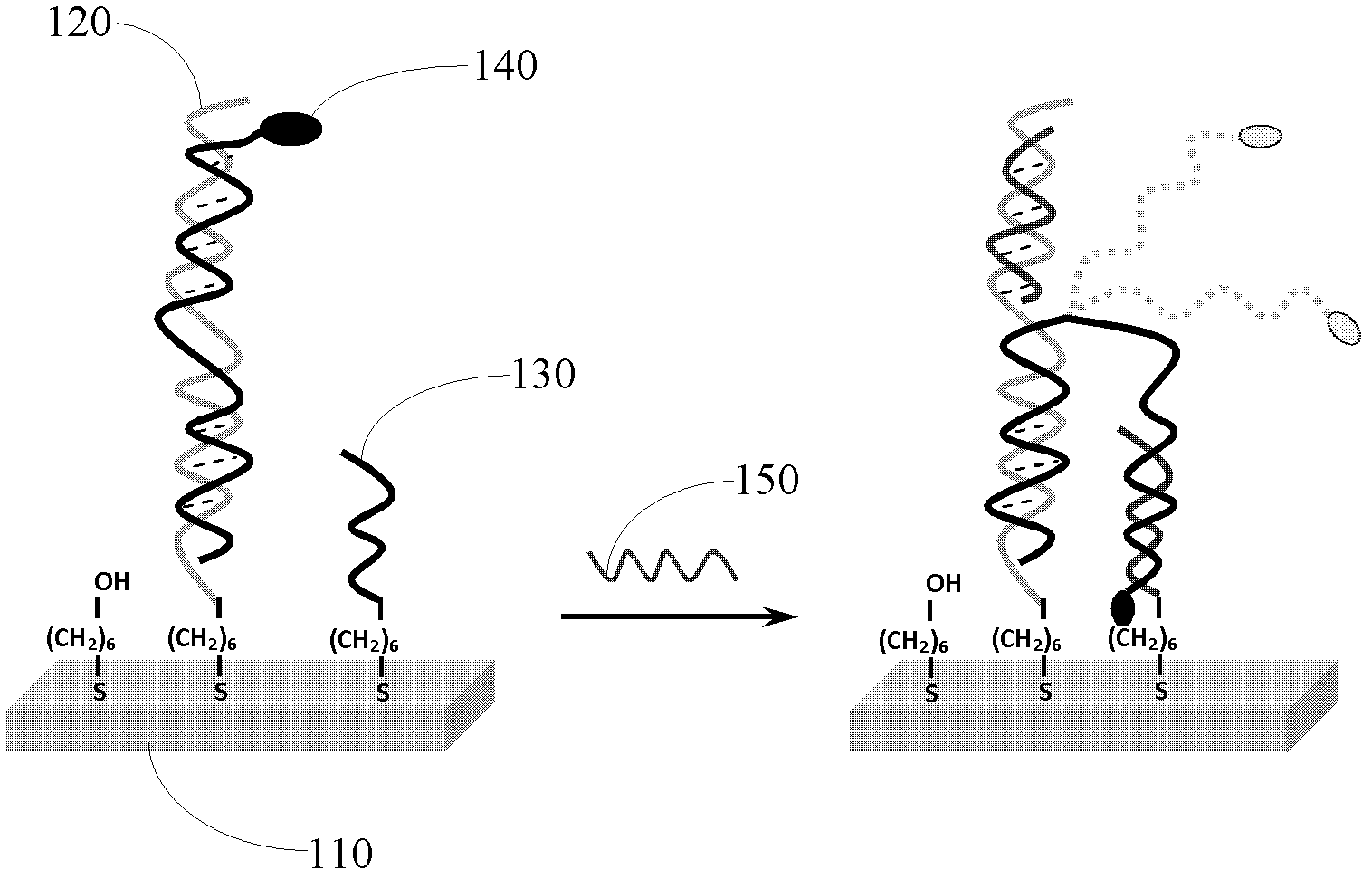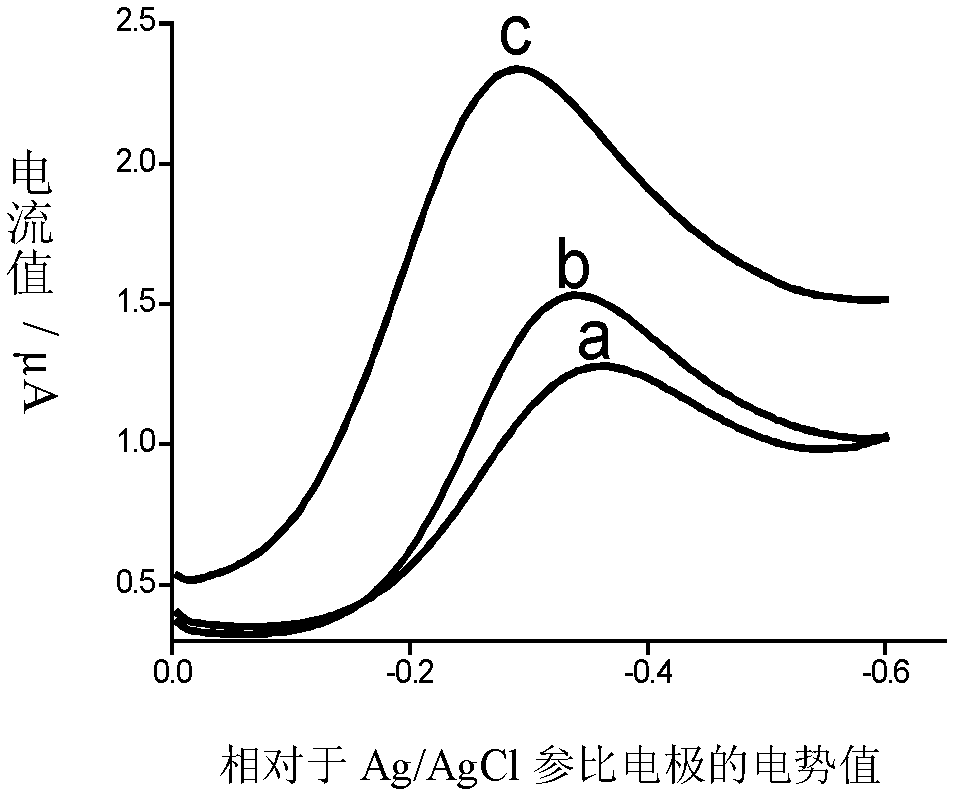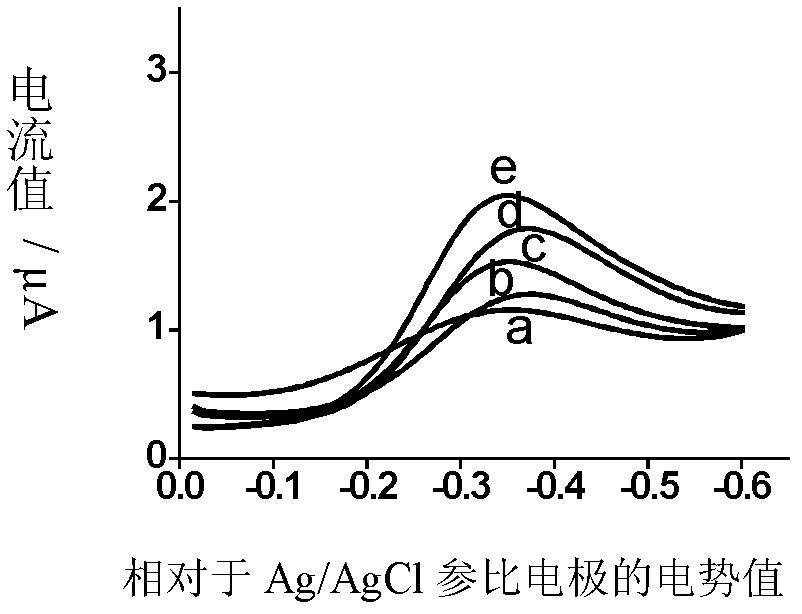Construction method for electrochemical sensor used for DNA single chain and protein molecule detection
A molecular detection and construction method technology, applied in the field of analysis and detection, can solve the problems of low signal value, low sensitivity, and high detection limit concentration of electrochemical sensors, and achieve high sensitivity, improve detection sensitivity, and low detection limit concentration.
- Summary
- Abstract
- Description
- Claims
- Application Information
AI Technical Summary
Problems solved by technology
Method used
Image
Examples
Embodiment 1
[0030] Such as figure 1 As shown, a gold disk electrode 110 with a diameter of 2.0 mm is taken, and then polished with aluminum oxide powder with a particle size of 1.0 mm, 0.3 mm, and 0.05 mm respectively, and then the gold disk electrode 110 is placed in two successively. Ultrasonic cleaning in sub-water, ethanol and acetone for many times. The cleaned gold disk electrode 110 is successively put into 0.5M sodium hydroxide solution and 0.5M sulfuric acid solution for electrochemical cycle scanning, washed with secondary water for several times, and then the gold disk electrode 110 is blown dry with high purity nitrogen. The treated gold disc electrode 110 was mixed with 0.5 μM capture probe 120 and 5.0 μM tris(2-carbonyl) in a 200 mM tris-hydrochloric acid buffer solution (hereinafter referred to as Tris-HCl) at pH 7.4. Ethyl)phosphorus hydrochloride was reacted at a temperature of 37°C and a duration of 16 hours. The DNA sequence of the capture probe 120 was: 5′-HS-(CH 2 ) 6 ...
Embodiment 2
[0034] Such as Figure 4 As shown, the pretreatment process of the gold disk electrode 210 is the same as in the first embodiment. The treated gold disk electrode 210 reacts with 0.5μM capture probe 220 and 5.0μM tris(2-carbonylethyl)phosphorus hydrochloride in a 200mM Tris-HCl buffer solution with a pH of 7.4 and a concentration of 200mM. The reaction temperature is 37℃, the duration is 16 hours, the capture probe 220 is the aptamer sequence of thrombin: 5′-HS-(CH 2 ) 6 -AGACAA GGA AAA TCC TTC CCC CCC CGG TTG GTG TGG TTG G-3'. Under the same buffer solution and reaction conditions, the gold disk electrode 210 is further reacted with 0.5μM additional probe 230. The DNA sequence of the additional probe 230 is: 5′-GGT TGG TGT GGT TGG-(CH 2 ) 3 -SH-3'. After the gold disk electrode 210 modified by the capture probe 220 and the additional probe 230 is washed with Tris-HCl buffer solution, it is further reacted with 6-mercaptoethanol in a 10 mM Tris-HCl buffer solution of pH 7.4 at ...
PUM
| Property | Measurement | Unit |
|---|---|---|
| Diameter | aaaaa | aaaaa |
| Particle size | aaaaa | aaaaa |
Abstract
Description
Claims
Application Information
 Login to View More
Login to View More - R&D
- Intellectual Property
- Life Sciences
- Materials
- Tech Scout
- Unparalleled Data Quality
- Higher Quality Content
- 60% Fewer Hallucinations
Browse by: Latest US Patents, China's latest patents, Technical Efficacy Thesaurus, Application Domain, Technology Topic, Popular Technical Reports.
© 2025 PatSnap. All rights reserved.Legal|Privacy policy|Modern Slavery Act Transparency Statement|Sitemap|About US| Contact US: help@patsnap.com



